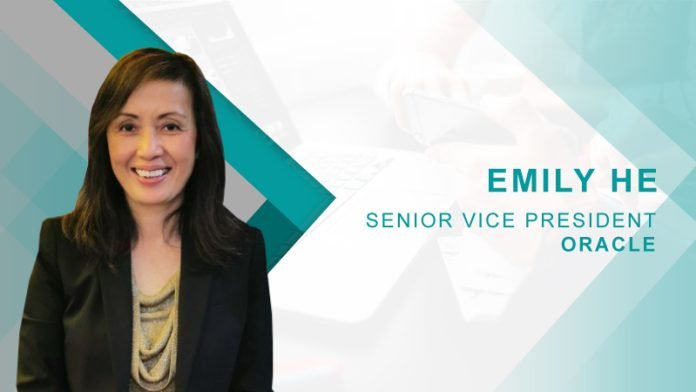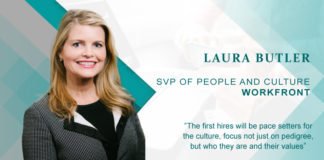Emily He, SVP at Oracle, discusses the benefits of an integrated HCM system over siloed point solutions and how it ultimately caters to enhanced employee experience & business management.
1. Can you tell us a little bit about yourself?
I’m a Silicon Valley technology veteran with 20 years of experience in enterprise software companies that span Human Capital Management (HCM), Enterprise Resource Planning (ERP), Customer Experience (CX), and Supply Chain. I live in San Francisco with my husband and two teenage children. In my spare time, I enjoy reading, urban farming, hanging out with friends, and globe-trotting with my family in tow.
My favorite movie is an oldie – Shawshank Redemption. For me, it embodies the core elements of human experience – perseverance, patience, resourcefulness, friendship, eternal hope, and the will to live and triumph against all odds.
2. Can you also share about your role at Oracle?
I am the global marketing lead for Oracle Fusion Cloud Human Capital Management (HCM). We offer a complete suite of HR solutions, serving notable enterprise customers including Kaiser Permanente, Macy’s, Marriott International, and Northwell Health. In my role, I am passionate about helping our customers navigate the ever-evolving future of work, through things like prioritizing workforce wellness, navigating new workplace models, adapting to different skills priorities, and humanizing the workplace with technologies.
3. Do you think the idea of “Modernizing HR” in an organization is ultimately going to meet HCM on its way?
In the long run, a complete, integrated HCM system will provide more benefits for a company than adopting siloed point solutions.
The right software will be able to automate complex HR tasks and provide insights by combining HR data from different functions, such as performance and compensation.
While there are HR tech solutions that focus on specific areas, HR leaders may find themselves making extra work for their teams to get different solutions to work together and gain usable insights. Cloud-based HCM solutions can help HR leaders save time by automating tedious administrative tasks, allowing them to focus more on strategic decision making. These systems can also give HR teams the flexibility to scale and adapt as their needs grow and change.
4. Why do you think companies are still skeptical about HCM integration? Do you think it is just limited to the cost factor or is there a bigger picture that we are not seeing?
I think the biggest reason that organizations may be slow to adopt integrated HCM solutions is that they don’t realize the benefits of using a modern HCM system.
Every company has had to figure out some way to manage their HR function, even if that solution requires manual processes or multiple disconnected platforms. From there, it’s easy to adopt an “If it ain’t broke, don’t fix it” mentality.
What they aren’t considering are the hidden costs, such as extra time spent making these solutions work together or attempting to gather insights about their workforce. In contrast, every function of an integrated cloud HCM solution works together seamlessly and provides HR teams with clear, curated data to guide strategic decisions.
Additionally, the way we work is changing rapidly. In the last year, alone, businesses had to adopt more digitized processes to maintain normal operations and workers are now expecting more personalized strategies when it comes to areas like wellness and employee experience. HR teams that are spending their time trying to work with outdated systems to meet the needs of a modern workforce are going to be left behind by companies that adopt cloud HCM.
5. Have you seen any changes in terms of HCM adoption post the pandemic? Can you perhaps share some data with us on this?
We have seen much greater adoption of cloud technology overall during the pandemic, including cloud-based HCM. For many companies, the speed and flexibility of cloud technology became an imperative as they needed to adapt rapidly to the changing business environment impacted by COVID-19. For example, HR teams that relied on paper-based processes needed to digitize their operations so that they could be run remotely and be able to support an entire virtual workforce.
On the other hand, some companies took time during the pandemic to reprioritize cloud-adoption projects that had previously been on the back burner. Many organizations realized that it was the right time for cloud transformations to both save costs in an unpredictable market and position themselves better for the future.
For example, a major healthcare customer adopted Oracle Cloud HCM during the pandemic in order to streamline their talent management processes onto a single platform and replace multiple ageing applications. Switching to cloud-based HCM helps HR teams adapt more readily to the changing work environment by creating more flexibility, allowing employees to work wherever they need, and delivering on-demand resources to improve employee experience. Regardless of the reason, adopting cloud-based HCM systems has helped businesses prepare for the future, whatever that might look like.
6. Oracle has quietly and steadily become An Essential Cloud Application. What according to you are the silver bullets of this journey?
The success of the Oracle Fusion Cloud Applications Suite, including Oracle Cloud HCM, boils down to two main points: we are the most complete enterprise management application suite and we are the only technology vendor to provide both technology and applications.
Oracle Cloud HCM fits into our complete suite alongside applications that serve every other business function, including finance, supply chain, sales and marketing. Because our applications work together seamlessly, we can provide better data and insights into the entire organization so that business leaders can make more informed decisions and drive the business forward as a whole, instead of in silos. For example, with Oracle Cloud HCM and Oracle Cloud Enterprise Resource Planning (ERP), HR leaders can collaborate with finance teams to make projections about budgets required to meet talent needs, or the impact of changes to benefits offerings. Nearly every decision, project, and planning cycle from one department have an impact on another function. By having a full suite of applications on one platform, it improves efficiency and performance across every area.
Additionally, designing and building the technology underneath our applications allows us to continuously improve the technology while we also improve our applications. This allows us to design our applications to make full use of the underlying technology. This also helps us offer updates to the applications at the pace of change in the business environment by releasing updates every quarter that our customers can use immediately.
7. With the Knowledge Gap Plaguing the Talent Acquisition & Talent Management Teams like never before, what capabilities do you think Oracle Dynamic Skills has to bridge the gap?
One of the biggest challenges facing HR teams is finding workers with the skills they need, even if they’re right there in plain sight. For example, someone with advanced AI/ML capabilities may describe their skills differently than what is listed in a job description or being searched for by a recruiter (e.g. saying they are experienced with “self-teaching algorithms to analyze data” when the job requires capabilities in “machine learning to generate insights.”).
Oracle Dynamic Skills helps bridge that gap by using AI to understand what skills a person has based on a variety of information including their resume, online profiles, performance reviews, and completed online learning courses. This makes it easier for organizations to find people with the right skills, no matter how they define their abilities.
Oracle Dynamic Skills also has the capability to help employees learn new skills by understanding their career goals and matching them with development opportunities such as training or mentorship. By helping employees develop their skillsets, companies can draw from their existing employees to find people with the skills needed to address new corporate goals.
8. What trends do you see shaping the HRTech arena in the next decade?
I think there are two major changes that appeared over the last year that will combine to have lasting implications on the HR and HR Tech landscape in the coming decade. First, the social distancing measures of the pandemic helped prove that remote work actually works. Businesses no longer need to tie employees to their office desks unless they see a strategic benefit from an in-person work model. At that same time, employees are finding their voice in a way they haven’t before.
The pandemic gave a lot of people time to reflect on their careers and think about what is really important to them and also gave them the courage to ask for what they want. The combination of those two factors is the major driver behind the current “Great Resignation” trend. Businesses are going to have to work a lot harder to retain talent going forward. “That’s the way we’ve always done it,” is no longer going to be an adequate explanation for any business practice. Over the next decade, HR tech vendors will need to focus on creating ways to help companies personalize employee experience and career development. This will help employees feel like their employers are taking their needs into account and giving them opportunities that align with their long-term goals.
9. What would be your one piece of advice for the upcoming HRTech Leaders?
My one piece of advice for HRTech leaders is to recognize that this year has led to a great awakening for both employees and employers. Employees figured out what they want and how to ask for it. It’s time for employers to figure out how to give it to them in order to create a happier and more productive workforce. Part of that means listening to viewpoints beyond the C-Suite. Before making a decision that impacts the entire workforce, get feedback from the workers at every level—and then use it. Businesses have the opportunity to embrace care in their workplace cultures in order to protect the mental and physical wellbeing of their employees.
For more such Updates Log on to www.hrtechcube.com

Emily He, Senior Vice President, Human Capital Management Cloud Business Group
Emily He is Oracle’s senior vice president of the human capital management cloud business group. Prior to joining Oracle, she was chief marketing officer of DoubleDutch, a leader in digital marketing solutions for events, conferences, and trade shows. Ms. He has 18 years of experience in various enterprise software roles, including marketing, corporate strategy, and business development at companies such as Siebel Systems, E2Open, and Saba Software.













